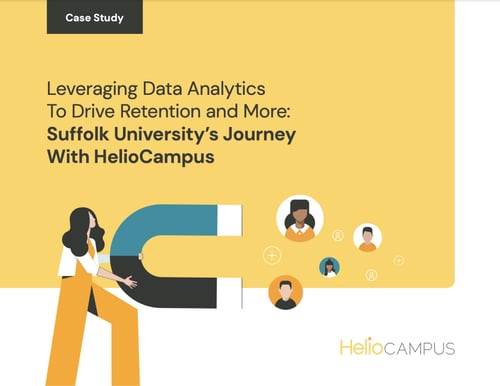Institutional Data Analytics
Leveraging Data Analytics to Drive Retention and More

Suffolk University
Founded in 1906 as a law school with a mission to expand equity in education, Suffolk University has grown to become a world-class private research institution that still prides itself on its commitment to underrepresented demographics. Today, the university serves 4,500 undergraduate students, 1,100 graduate students, and 1,300 law students from its campus hub in downtown Boston.
As the university began migrating to a new student information system (SIS), the institution realized they would also need a way to access legacy data. In 2019, Suffolk partnered with HelioCampus to build a data analytics platform that would allow for easier access to data and enable stronger decision-making around key initiatives—especially retention.
As the partnership developed, the university found itself benefiting from four major advantages of working with HelioCampus
Breaking Down Data "Siloes"
To make critical decisions, Suffolk leadership relied on data coming from a variety of different sources, such as the admissions office, the financial aid office, and the SIS. But compiling and analyzing that data was a challenge before implementing the HelioCampus analytics platform.
Using Dashboards for Easy Visualization
The ability to build dashboards inside the HelioCampus platform also made the data easier to access, visualize, and analyze. Previously, the institutional research team had to compile reports based on numerous Excel and .CSV files— a time-consuming process. This is saving hours of time for staff members, freeing them up to put their time toward more strategic initiatives.
Building a Predictive Model for Retention
Improving retention was a key motivator behind Suffolk’s data analytics program. After building the university’s new data platform, HelioCampus began creating a predictive model to help the university understand which factors affected retention.
Understanding How to Improve Retention
Once the Suffolk team had the results of the retention likelihood model, they saw opportunities from the data group of students with a Medium-Low likelihood ofretaining into the following Fall. Based on the findings of the model, the university now has a potential avenue to make interventions that could improve retention.
A Partnership That Yields More Than Data
From the original project of building a data platform and leveraging the partnership to help the university better understand retention, Suffolk’s relationship with HelioCampus has developed into something more. “There’s a reason why we’ve been with HelioCampus for four years—their entire team is wonderful,” says Holmes.



